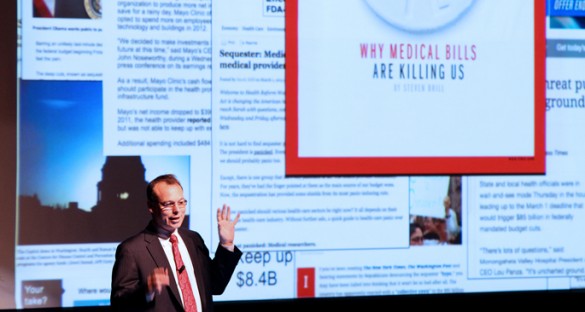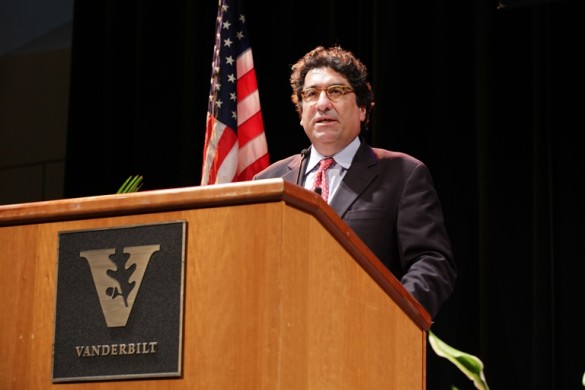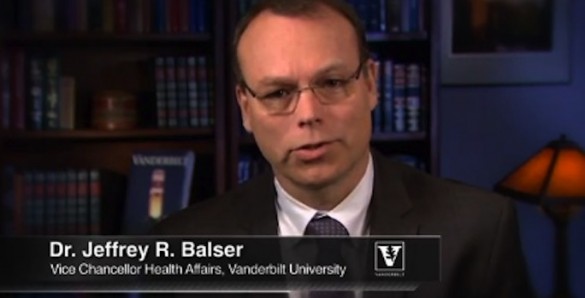
An overview of financial pressures created by the federal budget sequester and other legislation now facing Vanderbilt University Medical Center and academic health centers across the country was presented March 12 at two leadership forums — the Spring Clinical Enterprise Leadership Assembly held that morning at Langford Auditorium, and a faculty meeting focused on impact on the research community the same afternoon in Light Hall.
At both meetings the message was delivered by Jeff Balser, M.D., Ph.D., vice chancellor for Health Affairs and dean of the School of Medicine. The two events combined to draw approximately 1,100 faculty and administrators. Outlines for plans to realize $50 million in operational expense savings to address sudden federal funding reductions to education, research and patient care were presented.
(Click her to see answers to frequently asked questions about VUMC and economic repositioning)
Balser stressed that overall patient care volumes are strong throughout the Medical Center; staff and faculty are more productive than ever and fiscal year-to-date measures for patient care encounters are outpacing expectations in most areas.
However, an aging population has spelled continued growth in VUMC’s Medicare patient volumes, while at the same time reimbursements to treat this population are declining relative to actual cost. Also, myriad changes in payment methodology, such as reclassification of procedures from inpatient to outpatient, contribute to an ongoing decline in health system revenue. In addition, inflationary costs for medical equipment, medications and supplies are not matched by flat or declining insurance reimbursement rates to VUMC and other health systems.
Federal budget sequestration is bringing further pressures in the form of reduced funding for biomedical research from the National Institutes of Health (NIH). Vanderbilt, a world leader in biomedical research, is among the nation’s largest recipients of NIH funding.
To compound these challenges, the federal government is decreasing special payments to safety net hospitals like VUMC, payments designed to help offset losses for services to the uninsured. VUMC, like other health care institutions and chambers of commerce across the state, supports the expansion of TennCare/Medicaid as set out by the Affordable Care Act, but it remains unclear whether Tennessee lawmakers will choose to participate.
The $50 million operational efficiency plan outlined by Balser is spread over 18 months and aims above all to keep VUMC’s core missions fully intact. Much of the plan’s measures are culturally familiar from previous cost reduction efforts during the recession of 2008-09, focusing on operational efficiencies and discretionary programs in lieu of broader workforce staffing reductions.
To further lower operational costs, management teams across VUMC will engage workflow redesign processes to share administrative support services. A hiring freeze is also in effect until July 1 for all staff positions except those involving direct patient care.
VUMC will look closely for new opportunities to more effectively manage inpatient hospital stays and transitions of care, reduce clinic wait times and expand outpatient capacity.
Some new programs may be delayed, and programs peripheral to VUMC’s core missions of local and national leadership and excellence in health care, research, and education may face reduction or elimination.
During this period, VUMC will continue building the Vanderbilt Health Affiliated Network (VHAN), a regional network of affiliated health care providers and facilities. Balser stressed that affiliation is a low-cost approach to network development that does not involve ownership of additional hospitals by VUMC. The continued growth of VHAN is an essential economic strategy as payers begin reimbursing for clinical outcomes in a manner that requires population-based patient management.
The Spring Clinical Enterprise Leadership Assembly also featured a quarterly update delivered by David Posch, CEO of Vanderbilt University Hospital and Clinics, covering progress toward the Five Pillar goals for People, Service, Quality, Innovation and Growth/Finance.
During the course of his presentation Posch highlighted a number of successes including a 21 percent reduction in patient falls over 2.5 years, greatly reduced employee turnover through an innovative float pool strategy at the Monroe Carell Jr. Children’s Hospital at Vanderbilt, and exciting programs on the 6 North unit of Vanderbilt University Hospital that have greatly improved patient satisfaction.
At the afternoon Faculty Assembly, Balser and Susan Wente, Ph.D., associate vice chancellor for Research and senior associate dean for Biomedical Sciences, outlined more specifically the sequester’s impact on federal research funding. After speaking, both addressed questions about a range of topics including faculty recruitment, bridge funding and laboratory personnel recruitment and staffing.
For more information about the Clinical Enterprise Leadership Assembly, please visit the elevate website at https://www.mc.vander-bilt.edu/cgi-php/vunet/in-dex.html?req_url=%2Fvu-net%2Fvumc.php%3F-site%3DElevatesite (VU login required).















